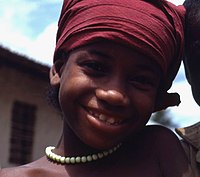 | |
| Total population | |
|---|---|
| 309,000[citation needed] | |
| Regions with significant populations | |
| 144,000 [1] | |
| 165,000 [2] | |
| Languages | |
| Loma, French, English | |
| Religion | |
| Traditional, Christianity, Islam | |
| Related ethnic groups | |
| Mende people, Kpelle people, Kissi people, Mano people, Vai people, Kono people, Gbandi people | |
The Loma people, sometimes called Loghoma, Looma, Lorma or Toma, are a West African ethnic group living primarily in mountainous, sparsely populated regions near the border between Guinea and Liberia.[3][4] Their population was estimated at 330,000 in the two countries in 2010.[5] They are closely related to the Mende people.[4]
The Loma speak a language in the Southwestern branch of the Mande languages, belonging to the Niger-Congo family of languages. The language is similar to the Kpelle, Mende, Vai, and Bandi languages.[3] The Loma refer to their language as Löömàgòòi [lɔːmàɡòːi] or Löghömàgòòi [lɔɣɔmàɡòːi]).[3] The Loma people, led by Wido Zobo and assisted by a Loma weaver named Moriba, developed a writing script for their language in the 1930s.[5] This writing script contains at least 185 characters.[6]
The Mandinka, Koniaka, and Kissi refer to the Loma as Toma.[1][3] Loma refer to themselves as Löömàgìtì (IPA: [lɔːmàɡìtì], or Löghömagiti [lɔɣɔmaɡiti] in Guinea).[3] They have retained their Traditional Religion, and resisted the Islamic jihads. The Loma people called the religious conflict with Mandinka people as a historic 'rolling war'.[7]
The Loma people are notable for their large wooden masks that merge syncretic animal and human motifs. These masks have been a part of their Poro secret rites of passage. The largest masks are about six feet high, contain feather decorations and believed by Loma to have forest spirits.[8]
The Loma people farm rice, but in shifting farms. They are exogamous people, with patrilineal social organization in matters related to inheritance, succession and lineage affiliations with one-marriage rule. Joint families, or virilocal communities are common, wherein families of brothers settle close to each other.[9]
The Loma people are also referred to as Buzi, Buzzi, Logoma, Toale, Toali, Toa, or Tooma.[10]
- ^ a b Lewis, M. Paul, ed. (2009). "Toma". Ethnologue: Languages of the World, Sixteenth edition. SIL International.
- ^ Lewis, M. Paul, ed. (2009). "Loma". Ethnologue: Languages of the World, Sixteenth edition. SIL International.
- ^ a b c d e Leopold, Robert Selig (1991). "2". Prescriptive Alliance and Ritual Collaboration in Loma Society (Thesis). Indiana University. Archived from the original on 2011-07-16.
- ^ a b Anthony Appiah; Henry Louis Gates (2010). Encyclopedia of Africa. Oxford University Press. p. 84. ISBN 978-0-19-533770-9.
- ^ a b Frank Sherman (2010). Liberia: The Land, Its People, History and Culture. New Africa Press. pp. 211–212. ISBN 978-9987-16-025-9.
- ^ Anthony Appiah; Henry Louis Gates (2010). Encyclopedia of Africa. Oxford University Press. p. 552. ISBN 978-0-19-533770-9.
- ^ Christian K. Højbjerg (2010), Victims And Heroes: Manding Historical Imagination In A Conflict-Ridden Border Region (Liberia-Guinea), in The Powerful Presence of the Past, Brill Academic, ISBN 978-9004191402, pages 273-294
- ^ Ayodeji Olukoju (2006). Culture and Customs of Liberia. Greenwood Publishing Group. pp. 61–62. ISBN 978-0-313-33291-3.
- ^ Currens, Gerald E. (1972). "The Loma Avunculate: An Exercise in the Utility of Two Models". Ethnology. 11 (2). University of Pittsburgh Press: 111–121. doi:10.2307/3773294. JSTOR 3773294.
- ^ RAMEAU, BnF [1]